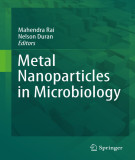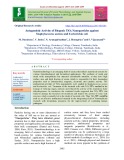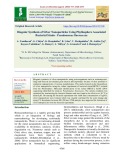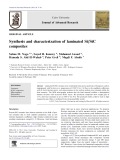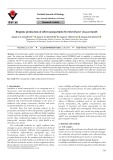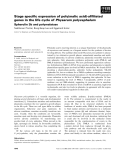
Biogenic synthesis
-
Ebook "Metal nanoparticles in microbiology" presents how they can be biosynthesized using bacteria, fungi and yeast, as well as their potential applications in biomedicine. It is shown that the synthesis of nanoparticles using microbes is eco-friendly and results in reproducible metal nanoparticles of well-defined sizes, shapes and structures. This biotechnological approach based on the process of biomineralization exploits the effectiveness and flexibility of biological systems.
 306p
306p  tachieuhoa
tachieuhoa
 28-01-2024
28-01-2024
 4
4
 2
2
 Download
Download
-
In this study, biogenic copper and zinc oxide nanoparticles (G-ZnONPs and G-CuONPs) were synthesized by the green synthesis method using Malva parviflora L. (Millow) leaf extract and the obtained nanoparticles were characterized in detail with UVVis, FTIR, SEM, XRD. The antibacterial properties of the synthesized nanoparticles on gram-positive and gram-negative bacteria were investigated and it was found that the nanoparticles had high antimicrobial activity in the results of the experiments.
 16p
16p  tudichquannguyet
tudichquannguyet
 29-11-2021
29-11-2021
 25
25
 1
1
 Download
Download
-
Nanobiotechnology is an emerging field of science that utilizes nanobased systems for various biotechnological and biomedical applications. The synthesis of metal and metal oxide nanoparticles has attracted considerable attention, as they have high surface area and high fraction of atoms which is responsible for their fascinating properties such as antimicrobial, magnetic, electronic and catalytic activity. The antibacterial activities of TiO2 nanoparticles were studied in Staphylococcus aureus and Escherichia coli.
 11p
11p  kethamoi6
kethamoi6
 29-06-2020
29-06-2020
 8
8
 1
1
 Download
Download
-
Biogenic synthesis of silver nanoparticles using microorganisms such as actinomycetes, fungi and bacteria has attained great interest and importance because of their potential to synthesize nanoparticles of various morphologies. This study focused on the biosynthesis of silver nanoparticles using the culture supernatant of bacterial strain BRTSI-2 isolated from the Phyllosphere. Molecular identification of the isolate BRTSI-2 by16S rDNA sequencing identified the strain as Pseudomonas fluorescens.
 6p
6p  trinhthamhodang5
trinhthamhodang5
 16-05-2020
16-05-2020
 13
13
 1
1
 Download
Download
-
Nanotechnology, an attractive branch of science deals with smaller particles with incredible efficiency. The applications of nanoparticles were widely distributed in all fields of science to enhance the reaction with ease. Despite of chemical and physical method of synthesis, biological methods has gained importance due to its less toxicity and cost efficiency. In the present study, silver nanoparticles (Ag NP’s) were synthesized using the culture supernatant of AcinetobacterindicusVLE-1 isolated from paper mill effluent.
 13p
13p  caygaocaolon2
caygaocaolon2
 14-03-2020
14-03-2020
 13
13
 0
0
 Download
Download
-
Nanotechnology plays a crucial role in addressing the innovations and solution to vast challenges in various fields. In recent years, green synthesis has gained extensive attention based on its reliability and stability. The use and development of nanomaterials using biogenic approach has several advantaged on environment and defined as nanoremediation. This beneficial technology can also be designed in order to decrease the risk of environmental pollution.
 7p
7p  caygaocaolon2
caygaocaolon2
 14-03-2020
14-03-2020
 17
17
 0
0
 Download
Download
-
The development of a protocol for biosynthesizing nanomaterial in an eco-friendly manner is a major concern in the field of microbial nanotechnology. In this study, microbial synthesis of silver nanoparticles (AgNPs) with a high level of bionanocatalytic activity was accomplished utilizing cell extracts of Penicillium digitatum FCMR-728 as the agents for reducing, capping and stabilizing. The presence of AgNPs was confirmed by an indication of a surface plasm on resonance band via UV–vis spectrum at 550 nm.
 14p
14p  nguaconbaynhay1
nguaconbaynhay1
 04-12-2019
04-12-2019
 15
15
 0
0
 Download
Download
-
Laminated Si/SiC ceramics were synthesized from porous preforms of biogenous carbon impregnated with Si slurry at a temperature of 1500 C for 2 h. Due to the capillarity infiltration with Si, both intrinsic micro- and macrostructure in the carbon preform were retained within the final ceramics. The SEM micrographs indicate that the final material exhibits a distinguished laminar structure with successive Si/SiC layers. The produced composites show weight gain of 5% after heat treatment in air at 1300 C for 50 h.
 8p
8p  kethamoi1
kethamoi1
 17-11-2019
17-11-2019
 12
12
 0
0
 Download
Download
-
A bacterial isolate capable of tolerating 30 mM silver nitrate (AgNO3) was recovered from soil contaminated with industrial waste. The isolate was identified by 16S rRNA as Enterobacter cloacae Ism26 (KP988024) and its capability to synthesize silver nanoparticles (AgNPs) was investigated.
 10p
10p  nutifooddau
nutifooddau
 27-01-2019
27-01-2019
 22
22
 1
1
 Download
Download
-
Polymalic acid is receiving interest as a unique biopolymer of the plasmodia of mycetozoa and recently as a biogenic matrix for the synthesis of devices for drug delivery. The acellular slime moldPhysarum polycephalumis charac-terized by two distinctive growth phases: uninucleated amoebae and multi-nucleated plasmodia.
 10p
10p  inspiron33
inspiron33
 26-03-2013
26-03-2013
 30
30
 4
4
 Download
Download
-
Psychiatric disturbance is common in both folate and cobalamin deficiencies. This, like the neuropathy, has been attributed to a failure of the synthesis of SAM, which is needed in methylation of biogenic amines (e.g., dopamine) as well as of proteins, phospholipids, and neurotransmitters in the brain (Fig. 100-1). Associations between lower serum folate or cobalamin levels and higher homocysteine levels and the development of Alzheimer's disease have been reported.
 5p
5p  thanhongan
thanhongan
 07-12-2010
07-12-2010
 56
56
 2
2
 Download
Download
CHỦ ĐỀ BẠN MUỐN TÌM








